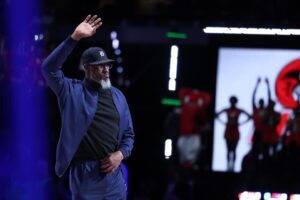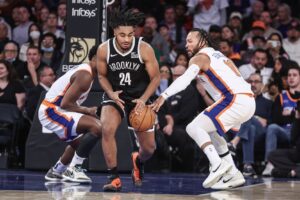Dirk Nowitzki played his final home game as a Dallas Maverick one year ago today. He has the sixth most points in league history. He owns the majority of Maverick records from games played, points, rebounds, blocks, and so much more. Sure, he owns the Mavericks records for most fouls and turnovers, but that’s a testament to his longevity.
Dirk Nowitzki is not only the greatest Maverick of all time but the greatest international player in the history of basketball. His legacy protrudes to levels so much larger than that, however. He changed the game of basketball. More than 20 percent of league players are international players and only a mere number of about five percent was the case during Nowitzki’s arrival. Out of the five major player awards given after the 2018-2019 season, four of the recipients were international players.
The game’s also not defined by a dominant post-player anymore. Look around. Teams are desperate for floor-spacing bigs and look at Kristaps Porzingis for example. The Unicorn and players like him are a luxury. It’s no coincidence Porzingis seemingly arrived in Dallas to take over Nowitzki’s reigns.
Other international superstars, like reigning Rookie of the Year Luka Doncic and reigning MVP Giannis Antetokounmpo look up to the Big German. They say he is a legend and that he continues to inspire them. Nowitzki’s legacy goes so much farther than the dimensions of a basketball court.
Remembering Dirk Nowitzki
NBA Draft and Early Years
Dirk Nowitzki was part of the 1998 NBA draft that produced a myriad of great players. This includes Vince Carter, Antawn Jamison, Rashard Lewis, Paul Pierce, and more. Of course, however, it was the no-name from Würzburg, Germany who stole the show.
He was actually drafted by the Milwaukee Bucks with the ninth overall pick. The Mavericks, who drafted forward Robert Traylor from the University of Michigan with the sixth overall pick, changed their minds and agreed on a draft-day trade with Milwaukee for Nowitzki. It’s safe to say that this ended up as one of the most lopsided trades in not just draft, but league history.
There is no other way to put it, Nowitzki struggled during his first year in the league. He was introduced to a new country and lifestyle, and a much more competitive and physical league than what he was previously used to. A common theme in his career, however, he simply pushed forward, worked harder, and in his sophomore campaign, he was a transformed player. He more than doubled his scoring and improved in every facet of the game. As the years went on, Nowitzki became a consistent starter and a 20-plus point double-double threat every night. He emerged as one of the best forwards in the game. And contrary to popular belief, Nowitzki’s game at the time was not about his signature one-legged fadeaway. As a matter of fact, it was quite the contrary, as his size and athleticism made him a defensive nightmare.
This period of Nowitzki’s career will always be remembered by the frightful “Big Three” he formed with Steve Nash and Michael Finley. The team, after the blossoming of Nowitzki, was built to contend for championships.
2006 Letdown and Following Years
The 2006 NBA Championship belongs to the Miami Heat. The Mavericks seemed to have the Finals in the bag, up 2-0. Dwyane Wade, however, took over the rest of the series to will the Heat to a 4-2 comeback. Some will say the series is riddled in controversy, but that’s a topic for another day.
Dirk Nowitzki willed the Mavericks into an incredible playoff run. His primary sidekicks included Josh Howard and Jason Terry, and that doesn’t necessarily scream championship-caliber team. The difference was Nowitzki, and he knew this, which is why the series loss hurt even more.
The following regular season is a testament to Nowitzki’s drive to win. The Mavericks finished 67-15 and the Big German was the MVP of the league. He is one of four international players to ever win the award. He averaged 25 points and nine rebounds per game on a 50-42-90 shooting split. Efficient is one word to describe his game.
The 2006-2007 playoffs are defined as heartbreak for the Mavericks. They fell to the “We Believe” eighth-seeded Golden State Warriors in the first round. That might be the biggest disappointment in Dallas’ franchise history.
Looking at the bright side after that, the organization knew they had the pieces to succeed and make the playoffs, but perhaps not a team built to win it all. They spent the next couple years making the playoffs but slowly building a team that had the necessary pieces.
2011 Season
All the disappointment of the past led to the creation of the 2010-2011 Mavericks roster. Nowitzki, of course, was the focal point of the team. Terry had stayed with the team throughout it all, as he cemented his place as the team’s second-option on offense. Veteran and former Maverick (now also a Hall of Famer) Jason Kidd was re-introduced. All-Star Shawn Marion, although past his prime, was also brought in. Defensive stalwart Tyson Chandler was present. Throw in more vital pieces such as J.J. Barea, DeShawn Stevenson, and Peja Stojaković, and the Mavericks had themselves a contending team.
The Mavericks entered the playoffs as the third seed in the West with a 57-25 record. They beat the Portland Trail Blazers, Los Angeles Lakers (a sweep of the reigning champions), and the Oklahoma City Thunder en route to the Finals. This included a plethora of stars like LaMarcus Aldridge, Brandon Roy, Kobe Bryant, Pau Gasol, Kevin Durant, James Harden, and Russell Westbrook.
2011 Champions
It was just perfect poetic justice that Nowitzki’s Mavericks matched up once again with the Heat in the 2011 Finals. Wade, however, was joined by Chris Bosh and LeBron James this time. After falling down a 2-1 deficit, Nowitzki willed the Mavericks back to win three games in a row and secure his first and only championship. Not only was it Nowitzki’s first championship, but the Mavericks’ as well, and it speaks levels to Nowitzki’s legacy to Dallas that fans will always see it as when Nowitzki got what he rightfully deserved for himself. With a few seconds left on the clock in Game Six, Nowitzki left the court in tears to enjoy the moment by himself in the locker room. He came out to hold the trophy and win the Finals MVP award, but that singular moment showed the basketball world just how much this meant to him.
The Twilight of Nowitzki
The 2011 Mavericks team goes down as one of the best stories in NBA championship lore. Not only did Dirk Nowitzki win his first, but so did all the other veterans. Looking at the roster, it really is a great story.
Unfortunately, however, Nowitzki’s post-championship career was not defined by more contention. He played admirably as he aged, and still made the playoffs a couple of times, but the team around was simply just not built to win.
Achievement is a solid word for this time in his career. Nowitzki, already the greatest Maverick of all time, continued to rack up both NBA and franchise records. He got the opportunity to play with more NBA legends (although past their prime) and mentored the future of Dallas in Doncic.
Another word to look at, however, is loyalty. All 21 years of Nowitzki’s career belong to the Mavericks. He never owed the team anything after his championship, but he stayed. He took pay cut after pay cut and passed opportunities to seek championships elsewhere. The team that believed in him was the team he decided to give his all to.
Modern sports seem to be about the money these days. Players constantly switch teams in search of the next big paycheck. This was not Nowitzki.
His impact was far beyond sports too. His philanthropic efforts across the city of Dallas, which he made is own, continue to impact the lives of thousands. A great example of this is the below video, narrated by Brad Townsend.
Mavericks fans eagerly await Nowitzki’s statue to be unveiled at the American Airlines Center, cementing his legacy as Dallas’ all-time great. He will be remembered as the overlooked sweet-shooting seven-footer from Germany who forever transformed the game of basketball.
Main Photo






